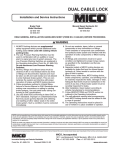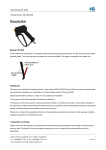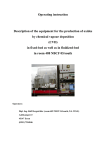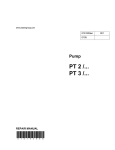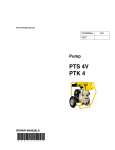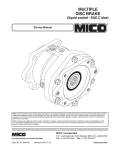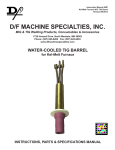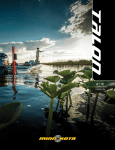Download 81550005Multiple Disc Brake
Transcript
Modular MULTIPLE DISC BRAKE (SAE D size) Service Manual This document is intended to provide general information about MICO Products. MICO, Inc. has attempted to present accurate information about MICO Products in its catalogs, brochures, and other printed materials. MICO, Inc. is not responsible for errors, inaccuracies, or inconsistencies that may exist in any catalog brochure or other printed materials or any damages arising from or related to reliance on information in them. Materials and specifications for MICO Products set forth in catalogs, brochures, and other printed materials are subject to change without notice or obligation. Refer to www.mico.com for the most recent versions of our literature. If you have any questions concerning MICO Products, please contact MICO, Inc. All MICO Products and service are sold and provided subject to the MICO Warranty at www.mico.com in effect on the date of sale or supply. MICO is a trademark and registered trademark of MICO, Inc. MICO is registered in the U.S. Patent and Trademark Office as well as in Australia, Canada, Indonesia, Japan, Peoples Republic of China, South Korea, and the European Community. MICO, Incorporated Innovative Braking and Controls Worldwide Form No. 81-550-005 1911 Lee Boulevard / North Mankato, MN U.S.A. 56003-2507 Tel: +1 507 625 6426 Fax: +1 507 625 3212 1990-01-01 www.mico.com TYPICAL BRAKE FIGURE 1 MICO, Inc. (2) Form No. 81-550-005 1990-01-01 PRINCIPLES OF OPERATION These brakes are spring-set, hydraulically released, multi-disc brakes. They are used primarily for holding loads, vehicles, conveyors, etc. in place when the hydraulic drive system is shut down or fails. Although the brakes are rated at 3000 PSI, they only require from 100 PSI to 390 PSI to make them function normally. The exact pressure required for operation is dependent upon the number of springs used to generate the torque necessary to hold the designed load. Thus, a brake with a full compliment of springs, will generate the highest level of torque and require approximately 390 PSI to fully release the brake and provide adequate running clearance for the individual discs. A brake with 1/2 of the full spring compliment will have 1/2 as much torque and will require only 200 PSI to fully release the brake. Consult catalog to choose the torque which best suits your design parameters. It is very important to remember that any pressure on the brake’s release piston will directly effect the level of torque. Two application examples: 1. The brake has a release pressure of 200 PSI. The actuation pressure is provided by a charge pump. During certain phases of the machines operation, the charge pump pressure dips from 200 PSI to 100 PSI. At 200 PSI, the brake runs free (zero torque) but at 100 PSI the brake will generate slightly less than half of its rated torque. The brake will drag failure may occur. In this case, a brake should be selected which has a lower release pressure. 2. A brake has a release pressure of 200 PSI. The system is set up to hold a load when a variable pump is shifted into neutral. Everything is running fine until the filter clogs, causing a build-up of back pressure in the return line to the tank. At a pressure of 60 PSI, the brake will lose 25% of its holding torque; thus the load may slip. The situation can be corrected by replacing the filter or adding an extra margin of safety to your required brake torque in the initial design. These brakes are designed to give thousands of trouble-free hours of service when set up correctly in the hydraulic circuit. DESCRIPTION OF MODEL NUMBERS OPTIONS (Available separately or in combination) D - Double Bearing S - Speed Sensor Z - Oil Cooled* OUTPUT FACE D - SAE D-Mount 4-Bolt OUTPUT SPLINE 13 - 13T 8/16 21 - 21T 16/32 17 - 17T 12/24 INPUT FACE D - SAE D-Mount C - SAE C-Mount R - Closed Face E - SAE E-Mount INPUT SPLINE 13 - 13T 8/16 21 - 21T 16/32 17 - 17T 12/24 14 - 14T 12/24 00 - Used with R Input Face only TORQUE *NOTE: Form No. 81-550-005 1990-01-01 On oil cooled models (Z - option) actual torque is 67% of value shown on torque code chart. (3) 1PSI = 0.06895 bar Initial Full Code Torque Release Release (lb�In) Pressure Pressure (PSI) (PSI) 20 20,000 250 390 16 16,000 200 300 13 13,000 160 250 12 12,000 150 240 10 10,000 130 190 90 9000 120 180 80 8000 100 150 55 5500 80 120 MICO, Inc. DISASSEMBLY 1. Remove four socket head assembly bolts (21). A suitable holding fixture is useful to keep brake in position. 2. Tap female end of spline shaft assembly (7) and spring plate (13) with soft mallet to separate cover. If sections will not separate, use a screwdriver to carefully pry sections apart. 3. Remove case gasket (6) from cover plate (5). 4. Remove retaining ring (1) from spline shaft assembly (7). 5. Remove spline shaft assembly (7) from cover plate (5) by tapping male end of spline shaft assembly with soft mallet. 6. Remove retaining ring (2) from cover plate (5) and press out oil seal (4) and bearing (3) if required. 7. Remove four socket head shoulder bolts (9). A suitable holding fixture is useful to hold brake in position. Do not remove shoulder bolts without pressurization of brake (approx. 400 PSI) or damage may result. 8. Remove primary disc (10), six thin rotor discs (11), two thick rotor discs (22) and seven stator discs (12). 9. Release the pressure to brake before removing four socket head cap screws (8). 10. Remove spring plate (13). 11. Remove case gasket (6) from spring plate (13). 12. Before removing springs (14), not pattern and color for reassembly purposes. 13. Remove piston (15) by carefully exerting hydraulic pressure to the release port in the pressure plate (20). 14. Remove outside and inside o-rings (17 & 19) and outside and inside back-up rings (16 & 18) from piston (15). Care must be taken so as not to scratch or mar piston. MICO, Inc. ASSEMBLY LUBRICATE ALL RUBBER COMPONENTS FROM REPAIR KIT WITH CLEAN TYPE FLUID USED IN TYPE SYSTEM. 1. Clean all parts thoroughly before assembling. 2. Press oil seal (4) into cover plate bore (5) until it is flush with bearing shoulder. DRY DESIGN BRAKE; oil seal (4) must be installed with open side facing pilot end of cover (5). LIQUID COOLED BRAKE; oil seal (4) must be in stalled with closed side facing pilot end of cover (5). 3. Press bearing (3) into position until it bottoms out on oil seal borestep. 4. Install retaining ring (2) into cover plate (5). 5. Press spline shaft assembly (7) into bearing (3) until shaft bottoms on shaft shoulder. Bearings inner race must be supported during this operation. 6. Install back-up rings (16 & 18) on piston (15) toward spring pockets. 7. Install o-rings (17 & 19) on piston (15). Be sure o-rings are flat and all twists removed. to hold brake in position. 12. Install stator discs (12) and rotor discs (11 & 22). Begin with a thick rotor disc (22) and alternate with stator discs (12) and thin rotor discs (11). Complete with thick rotor disc (22). 13. Install primary disc (10). 14. Align discs and partially screw in four socket head shoulder bolts (9). SEE NOTE BELOW. Inspect for free movement of stack. Pressurize brake release port (approx. 400 PSI) to release discs. Torque shoulder bolts to 15 ft·lb and release pressure. A suitable holding fixture is useful to hold brake in position. 15. Install cover plate (5) using four socket head assembly bolts (21). SEE NOT BLOW. Torque cap screws to 55 ft·lb. NOTE Bolts should have one or two drops of Henkel Omnifit #1550 or Loctite #609 applied to threads. Care must be taken so as not to scratch or mar piston. 8. Lubricate piston (15) with clean type fluid used in the system. Carefully press piston into pressure plate (20). Be sure piston is aligned correctly at all times and that there are no extrusions. Press piston until it bottoms on pressure plate (20). 9. Install same number of springs (14) according to pattern and color as were removed during disassembly. Different colored springs must be alternated. 10. Affix self-adhesive case gaskets (6) to cover plate (5) and spring plate (13). 11. Place unit on a press. Using a fixture, depress and install four socket head cap screws (8). SEE NOTE BELOW. Torque cap screws to 55 ft·lb. A suitable holding fixture is useful (4) Form No. 81-550-005 1990-01-01 FOR REPAIR KIT INFORMATION REFER TO PAGE 7. FIGURE 2 ITEM 1 2 3 4 5 6 7 8 9 10 DESCRIPTION ITEM 11 12 13 14 15 16 17 18 19 20 21 22 RETAINING RING RETAINING RING BEARING OIL SEAL COVER PLATE CASE GASKETS SPLINE SHAFT ASSEMBLY SOCKET HEAD CAP SCREWS (ASSEMBLY BOLTS) SOCKET HEAD SHOULDER BOLTS (TENSION PINS) PRIMARY DISC Form No. 81-550-005 1990-01-01 (5) DESCRIPTION ROTOR DISCS STATOR DISCS SPRING PLATE SPRINGS PISTON BACK-UP RING O-RING BACK-UP RING O-RING PRESSURE PLATE SOCKET HEAD ASSEMBLY BOLTS ROTOR DISC (THICK) MICO, Inc. BLEEDING 1. Install brake in system and connect pressure lines. 2. Bleed pressure release section of brake by pressurizing side inlet port and allowing air to escape from top port. Pressure should not exceed 100 PSI during bleeding. 3. Apply sufficient pressure to release brake and check for proper operation in system. SERVICE DIAGNOSIS PROBLEM Brake slips Brake drags or runs hot Brake will not release MICO, Inc. CAUSE EXPLANATION ACTION A. Excessive pressure in hydraulic system If there is back pressure in the actuation line of the brake, holding torque will be reduced. Check filters, hose size, restrictions in other hydraulic components. B. Oil in brake if designed for dry use Wet linings generate 67% of the dry torque rating. If the brake has oil in it, check the type of oil hydraulic or gear box. 1. Gearbox oil 2. Hydraulic oil Replace oil seal in brake Check motor seal Check piston seals Note: Internal components will need to be inspected, cleaned and replaced as required. C. Disc plates worn The thickness of the disc stack sets the torque level. A thin stack reduces torque. Check disc thickness D. Springs broken or have taken a permanent set Broken or set springs can cause reduced torque - a rare occurrence. Check release pressure (See spring replacement) A. Low actuation pressure The brake should be pressurized to minimum of 20 PSI over the full release pressure under normal operating conditions. Lower pressures will cause the brake to drag thus generating heat. Place pressure gauge in bleed port & check pressure with system on B. Bearing failure If the bearing should fail, a large amount of drag can be generated. Replace bearing C. Oil in brake Excess fill of oil in sump condition thru wet brakes can cause the unit to run hot. Also excessive rpm in sump condition. Drain oil and refill as specified for brakes or Switch to flow thru cooling. A. Stuck or clogged valve Brakes are designed to come on when system pressure drops below stated release pressure. If pressure cannot get to brake, the brake will not release. Place pressure gauge in bleed port - check for adequate pressure Replace defective line or component B. Bad o-rings If release piston will not hold pressure, brake will not release. Replace o-rings C. Discs frozen These brakes are designed for only limited dynamic braking. A severe emergency stop or prolonged reduced release pressure operation my result in this type of damage. Replace disc stack (6) Form No. 81-550-005 1990-01-01 REPAIR KITS Form No. 81-550-005 NUMBER DESCRIPTION 12-504-116 O-ring and Back-up Ring Kit Case Gaskets (6) Oil Seal (4) Back-up Rings (16 & 18) O-rings (17 & 19) Loctite 12-501-118 Lining Kit Case Gaskets (6) Primary Disc (10) Stator Discs (12) Rotor Discs (11 & 22) Loctite 12-501-122 Bearing Kit Case Gaskets (6) Bearing (3) Oil Seal (4) Loctite 12-501-128 Spring Kit Case Gaskets (6) Springs (14) Loctite 1990-01-01 (7) INCLUDES MICO, Inc.







